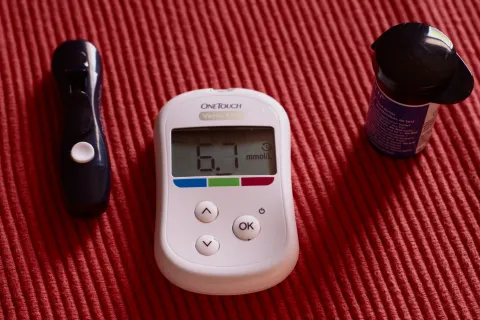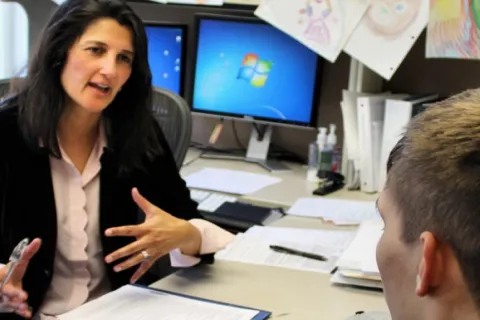Recognizing anxiety in children and teens with autism
By Dr. Roma VasaThe answers in this Q&A come from child and adolescent psychiatrist Roma Vasa. Dr. Vasa practices at the Kennedy Krieger Institute, with a specialty in treating anxiety in children and adolescents with developmental disorders.
Earlier this year, the journal Pediatrics published the first guidelines for identifying and addressing anxiety in children and teens with autism. The guidelines came out of a study conducted through the Autism Speaks Autism Treatment Network (ATN) in its role as the Autism Intervention Research Network on Physical Health (AIR-P).
Research has long shown that people with autism have high rates of anxiety disorders.
Research has long shown that people with autism have high rates of anxiety disorders. Research also suggests that anxiety tends to have different causes and symptoms in those affected by autism than it does in the general population.
For these reasons, the Autism Speaks ATN prioritized the development of the diagnostic and treatment guidelines that became part of a special ATN/AIR-P supplement to the February issue of Pediatrics.
Q&A with Dr. Vasa on identifying and addressing anxiety in children and teens with autism
We asked the lead author of the report to talk about the great need for the study; how doctors, parents and young patients can best use the resulting guidelines; and what’s next in addressing mental health challenges in the autism community.
Autism Speaks: Why are these new guidelines so important?
Dr. Vasa: They represent an all-important starting point, the first set of evidence-based medical guidelines for identifying, evaluating and addressing anxiety disorders in children and adolescents with autism. We pulled together the best scientific and medical evidence to guide us. But we’re still learning about anxiety in kids with autism. In the coming years, we want to refine these guidelines based on ongoing research and clinical practice. In particular, we hope to expand the treatment section based on current and future clinical studies. Meanwhile, we have this first set of guidelines to offer the nation’s pediatricians, child psychiatrists and psychologists. That’s so important because the problem is huge, and clinicians have been struggling to make sense of the situation.
Your team’s report in Pediatrics cites research suggesting that, overall, nearly 40 percent of children and teens with autism have an anxiety disorder. Is this rate the same across childhood?
To date, most studies have looked at anxiety in children and adolescents who have autism. We’re just starting to see studies on anxiety in preschoolers. That said, the evidence suggests that, for many children with autism, anxiety starts increasing with adolescence. Often, the development of an anxiety disorder coincides with the onset of puberty and the transition to middle school. This tends to be a time of new expectations and a decrease in supportive special education programming. All these things may contribute to anxiety in adolescents on the autism spectrum.
The report also notes that many children and teens with autism have more than one anxiety disorder. What types of anxiety are particularly common?
Many of the studies are identifying high rates of social anxiety disorder and generalized anxiety disorder. Specific phobias also appear to be particularly common and we’re beginning to wonder about traumatic anxiety. It’s important to remember that children with autism are vulnerable to being trauma victims – for example, from bullying and peer rejection.
In what ways does anxiety tend to be different in children and adults with autism than in other people, and why is it important to understand these differences?
We know that some of the anxiety is wrapped around autism symptoms. Take, for example, sensory over-reactivity to stimuli such as noises, lights, even tastes and smells. This can result in what we call anticipatory anxiety. In other words, with anticipatory anxiety disorder, just thinking about encountering the sensory stimulus can produce anxiety. We also see anxiety around the need for sameness. That, too, can produce anticipatory anxiety in the face of a change in schedule or a new teacher or aide.
We’re also learning that the standard anxiety disorders may look different in people who have autism. For example, one of the core features of social anxiety disorder is that a child feels judged and embarrassed. We suspect that some kids with autism may have difficulty expressing the thought process behind such feelings. In addition, their social anxiety may manifest differently – for example with irritability and withdrawal.
We also need to better understand what “worry” looks like in children with autism. Again, they may manifest worry with different behaviors than other children do.
To date, most of our work addressing anxiety in kids with autism has focused on children with normal to high intelligence. We need to do much more work on understanding anxiety in children who have autism with intellectual disability.
Why is anxiety often difficult to recognize in those who have autism?
One thing to remember is that anxiety is an internalizing symptom. That means kids experience it inside. So anxiety can be hard to recognize in any child, even without autism. Adding to that difficulty, kids who have autism often have difficulty connecting what they are experiencing externally with what they are feeling internally. Many have difficulty expressing feelings.
So it can be hard to find out from the individual what is going on inside. Often we have to identify anxiety by evaluating behavioral and mood symptoms. So a parent might say, “My child went to a party and then got irritable and had a meltdown and we had to leave.” The child just says, “I don’t want to go to parties anymore.” That experience followed by those behaviors makes us think that the child may have “anxiety” even if the child can’t express that he or she is feeling anxious.
We also need to keep in mind that some of the classic symptoms of anxiety overlap with autism symptoms. Take, for example, social avoidance. In a child who has autism, social avoidance might result from being indifferent about social situations or it could stem from anxiety around interacting with others.
Similarly, rigidity, or the need for sameness, is another feature of anxiety – when it stems from trying to control a fearful situation. But of course rigidity is also symptom of autism.
So we encourage clinicians to ask the question, “Have these behaviors gotten worse?” It’s vital to get to know the child’s baseline autism symptoms in order to recognize whether there is anxiety on top.









